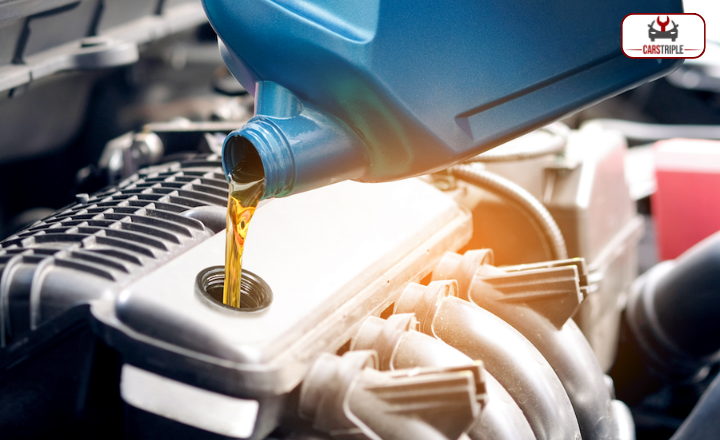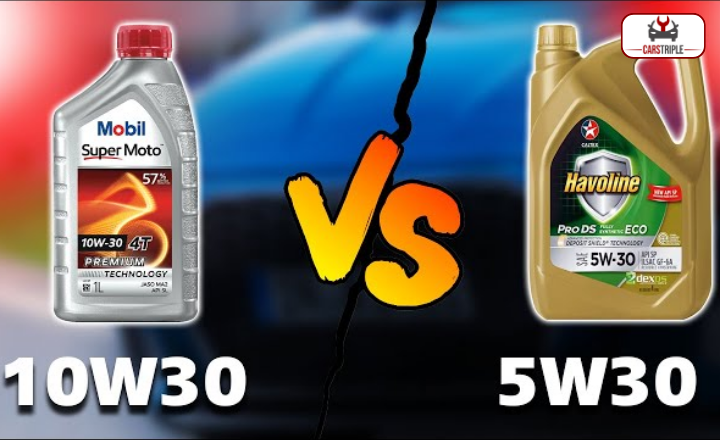The health of your car heavily relies on the type of motor oil you use. This oil protects your engine from damage and helps other parts work smoothly. But it’s not as simple as just buying and using oil; there’s more to consider
Different types of oils have their advantages and disadvantages. Picking the right one can make a big difference. Now, let’s look at the differences between 5W-30 and 10W-30 oils. At first glance, they might seem the same, but there are significant differences you need to know about.
What Is 10W-30 oil?
Motor oil has an interesting feature – a rating system made by the Society of Automotive Engineers (SAE). This rating tells us about the oil’s thickness and flow, known as viscosity. It might not seem important, but oil is like the blood of a car.
It helps everything move smoothly inside your vehicle. The thickness of the oil can change depending on how hot or cold it is, which affects how well your car runs. There are codes to understand this, like ‘W’ for winter viscosity and numbers for hot viscosity.
These codes tell you how well the oil works in different temperatures. For example, when you see 10W-30 on an oil container, 10 is its cold temperature rating. A smaller number means less thickness.

To break it down further, 10W-30 oil is thick when cold but thinner during everyday use. This makes it great for hot climates. But, if the weather is freezing, this oil might not work as well because of its thickness. Like the old saying – you can’t always tell what’s inside by looking at the outside.
Knowing your car’s engine oil well can help you better understand your vehicle and even make it last longer! The beauty of 10W-30 oil is that it shines in hot climates because it can handle high temperatures without hurting your engine’s performance.
This is a significant advantage when you’re using your car a lot or carrying heavy loads, which puts extra stress on the machine. Oil of this grade doesn’t fare well in the harsh cold of winter. It gets thicker when it’s cold, making your car work harder to heat it and move it around the engine.

This can impact how much gas you use when starting your vehicle. But everything should be fine again once your car warms to its average temperature. Knowing these things can help you make intelligent choices for your car’s needs in different weather and work conditions.
People who drive a lot in city traffic or use their engines hard will see the benefits of 10W-30 oil. It’s thicker, which helps seal better and gives more protection against everyday wear and tear. This potent formula lowers friction between engine parts, leading to smoother running and longer engine life.
The 10W-30 oil isn’t just for cars. It can also work with some biofuel models due to its adaptability. This oil is excellent, especially for older vehicles with more significant gaps, because it has a thick consistency that seals them well. But remember to check your car’s manual or ask your mechanic to make sure it’s the right fit for your vehicle.
10W-30 Oil Pros And Cons
Pros:
- 10W-30 oil is resistant to high temperatures, maintaining engine efficiency.
- It minimizes wear and tear, especially in stop-and-go driving conditions.
- Ideal option for cars frequently used for heavy-load transportation.
- Being a thicker oil, it enhances the sealing action of your car’s engine.
Cons:
- If the winter viscosity rating is high, the oil becomes denser in cold weather.
- The car requires more effort to circulate this thick oil during ignition.
What Is 5W-30 oil?
The 5W-30 oil stands out because it boosts car performance in cold weather. This is unlike the 10W-30 type, which needs more energy to start your car when it’s hard. The flexibility of the 5W-30 oil means your engine starts quickly and stays well-lubricated.
This lessens the work at the start, improving fuel efficiency and making your engine last longer – a great benefit as winter approaches. The numbers in ‘5W-30’ tell us more than you might think. We’ve already discussed how ‘5W’ means the oil stays thin in cold temperatures for easy car starting.

The second number, ’30’, tells us that the oil can remain thick and keep lubricating even at high temperatures. This helps engines last longer by stopping them from overheating and wearing out too quickly during hot weather or summer driving conditions.
Choosing 5W-30 oil can make your engine start more smoothly. It lessens the pressure on the machine and keeps its internal parts in better shape compared to thicker oils like 10W-30. This oil type is excellent for driving in freezing conditions because it makes your engine work relatively easy when starting up in cold weather.
But 5W-30 oil could be better. Its thinness can be a disadvantage. Unlike the 10W-30, it doesn’t seal as firmly, which might not work well for city driving involving much stopping and starting. Also, this lighter oil may not perform as well when you often carry heavy loads or put your car under much stress.
5W-30 engine oil is excellent for many settings. It might not stay the same in high heat compared to 10W-30 engine oil. But it’s still suitable for regular city drives or highway trips in smaller cars like sedans. These cars get less hot and face less pressure.
The exceptional thickness of 5W-30 makes it work well in all weather conditions. It works best between -18 C to 35 C temperatures, which makes it different from other oils. This oil can also be used in light-duty petrol and diesel engines, making it a top pick for many vehicles. But remember, always check your car’s manual or ask a professional to ensure this oil suits your car’s needs.
5W-30 Oil Pros And Cons
Pros:
- The lower viscosity of this oil in cold conditions aids in starting cars during freezing temperatures.
- Its versatility to function efficiently in cold and average temperatures qualifies it as a suitable all-around oil type.
- Like the 10W-30 oil, its performance is excellent at average operating temperatures.
Cons:
- Less efficient in minimizing engine deterioration during stop-and-go situations.
- 5W-30 oil struggles to retain stability under a heavy workload compared to 10W-30 oil.
- There are better options for regular heavy-load transportation.
Which Oil To Use

There’s often confusion about which oil is best to use – 5W-30 or 10W-30. Let’s clarify the actual differences between 5W-30 and 10W-30. To simplify, you can think of 10W-30 oil as a sturdy workhorse. It can handle harsh conditions without problems. This oil is excellent for complex jobs because it keeps cars running smoothly, even when stopping and starting a lot or carrying heavy loads.
On the other side, 5W-30 oil can easily adjust to different temperature extremes. This motor oil isn’t bothered by cold weather. It does well in it! Because it works great in hot and cold conditions, many people like to use it all year round.
It’s like having a versatile friend who always performs well no matter the weather! No matter how you drive or what kind of weather your car has to deal with – from hot summer sun to icy winter frost – you can count on 5W-30 to deliver excellent performance!
Choosing between 5W-20 and 10W-30 engine oil requires careful thought, not just guesswork. There’s no such thing as the best oil – it depends on your car’s specific details and the weather conditions you usually drive in.
For example, 5W-20 oil is a good choice for smaller cars or driving in cold weather. But if you’re dealing with hot weather or driving a heavy-duty vehicle, 10W-30 oils could be better because they perform well under high heat or heavy loads.
The key is to choose the right product for your specific needs and daily challenges rather than trying to find one that works for everything. Your car deserves this kind of personalized care – every detail counts! While 5W-30 oil might be refined for regular city driving, it might not be up to towing a trailer in hot summer weather or running an old car with wide engine clearances. It all comes down to your circumstances.
Conclusion
To sum up differences between 5W-30 and 10W-30 oils, each have their benefits. The main difference is how they flow at various temperatures. For example, 5W-30 is excellent for cold weather and helps save fuel. It also makes your car run smoother in the cold. On other side, 10W-30 works best in hot weather or for older cars. Think about what your car requires and your living location when deciding between these two. Your mechanic can also give you some good advice. The goal is to keep your engine well-oiled no matter the conditions for the best possible performance. Always talk to a mechanic you trust before deciding which oil to use in your car.
FAQ’s
What’s the main differences between 5W-30 And 10W-30 oil?
The main difference lies in their viscosity at low temperatures. 5W-30 is thinner at cold temperatures than 10W-30, making it easier to start your engine in colder climates.
Is there a significant price difference between 5W-30 and 10W-30 oils?
Motor oils of both kinds usually cost about the same. The price might vary a little, but only based on things like the brand or where you buy it from.
Read More:

